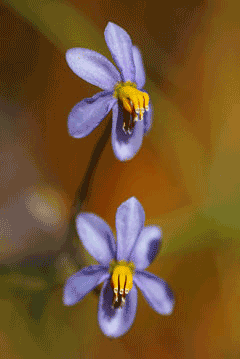 |
|
http://flickr.com/photos/clairewoods/ |
 |
|
Translate this page:
Summary
Physical Characteristics

 Cyanella hyacinthoides is a BULB growing to 0.3 m (1ft) by 0.2 m (0ft 8in).
Cyanella hyacinthoides is a BULB growing to 0.3 m (1ft) by 0.2 m (0ft 8in).
See above for USDA hardiness. It is hardy to UK zone 9 and is frost tender. It is in flower from July to August. The species is hermaphrodite (has both male and female organs) and is pollinated by Bees.
Suitable for: light (sandy) soils and prefers well-drained soil. Suitable pH: mildly acid, neutral and basic (mildly alkaline) soils. It cannot grow in the shade. It prefers dry or moist soil and can tolerate drought.
UK Hardiness Map
US Hardiness Map
Synonyms
Plant Habitats
South Wall. By. West Wall. By.
Edible Uses
Edible Parts: Root
Edible Uses:
Bulb - cooked[177]. An onion substitute.
References More on Edible Uses
Medicinal Uses
Plants For A Future can not take any responsibility for any adverse effects from the use of plants. Always seek advice from a professional before using a plant medicinally.
None known
References More on Medicinal Uses
The Bookshop: Edible Plant Books
Our Latest books on Perennial Plants For Food Forests and Permaculture Gardens in paperback or digital formats.

Edible Tropical Plants
Food Forest Plants for Hotter Conditions: 250+ Plants For Tropical Food Forests & Permaculture Gardens.
More

Edible Temperate Plants
Plants for Your Food Forest: 500 Plants for Temperate Food Forests & Permaculture Gardens.
More

More Books
PFAF have eight books available in paperback and digital formats. Browse the shop for more information.
Shop Now
Other Uses
References More on Other Uses
Cultivation details
Prefers a light sandy soil. Requires a very warm sunny position in a very well-drained soil, it is best grown at the foot of a south-facing wall or in a south-facing bed. Plants have deeply seated corms and are very drought resistant once established[282]. Plants are not very frost hardy, but they can be grown outdoors in the milder areas of the country if given a good mulch[1, 200]. Plant the bulbs 15cm deep in autumn to flower in spring or in the spring to flower in the summer[1, 200]. Lift the bulbs when they die down, dry them and store in a cool place until it is time to replant[1]. Flowers are produced in 3 - 4 years from seed[200].
References Carbon Farming Information and Carbon Sequestration Information
Temperature Converter
Type a value in the Celsius field to convert the value to Fahrenheit:
Fahrenheit:
The PFAF Bookshop
Plants For A Future have a number of books available in paperback and digital form. Book titles include Edible Plants, Edible Perennials, Edible Trees,Edible Shrubs, Woodland Gardening, and Temperate Food Forest Plants. Our new book is Food Forest Plants For Hotter Conditions (Tropical and Sub-Tropical).
Shop Now
Plant Propagation
Seed - sow the seed thinly in the autumn in a greenhouse so that it will not be necessary to thin the seedlings. Once the seed has germinated, grow on the seedlings in the same pot for their first year[200], giving an occasional liquid feed to ensure that they do not become mineral deficient. Pot up 2 - 3 small bulbs to a pot when the plants are dormant and grow them on in a greenhouse until the bulbs reach flowering size. Plant them out in the spring, after the last expected frosts. Division of offsets when the plants are dormant. Larger bulbs can be planted straight out into their permanent positions, but it is best to pot up the smaller bulbs and grow them on for a year in a cold frame before planting them out.
Other Names
If available other names are mentioned here
Native Range
Coming Soon
Weed Potential
Right plant wrong place. We are currently updating this section.
Please note that a plant may be invasive in one area but may not in your area so it's worth checking.
Conservation Status
IUCN Red List of Threatened Plants Status :

Growth: S = slow M = medium F = fast. Soil: L = light (sandy) M = medium H = heavy (clay). pH: A = acid N = neutral B = basic (alkaline). Shade: F = full shade S = semi-shade N = no shade. Moisture: D = dry M = Moist We = wet Wa = water.
Now available:
Food Forest Plants for Mediterranean Conditions
350+ Perennial Plants For Mediterranean and Drier Food Forests and Permaculture Gardens.
[Paperback and eBook]
This is the third in Plants For A Future's series of plant guides for food forests tailored to
specific climate zones. Following volumes on temperate and tropical ecosystems, this book focuses
on species suited to Mediterranean conditions—regions with hot, dry summers and cool, wet winters,
often facing the added challenge of climate change.
Read More
Expert comment
Author
L.
Botanical References
200
Links / References
For a list of references used on this page please go here
Readers comment
| Add a comment |
|
If you have important information about this plant that may help other users please add a comment or link below. Only comments or links that are felt to be directly relevant to a plant will be included. If you think a comment/link or information contained on this page is inaccurate or misleading we would welcome your feedback at [email protected]. If you have questions about a plant please use the Forum on this website as we do not have the resources to answer questions ourselves.
* Please note: the comments by website users are not necessarily those held by PFAF and may give misleading or inaccurate information.
To leave a comment please Register or login here All comments need to be approved so will not appear immediately.
|
Subject : Cyanella hyacinthoides
|
|
|
|